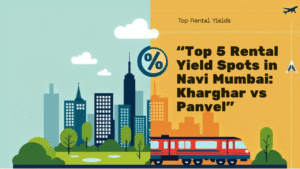Chhattarpur, tucked into South Delhi’s green belt, offers a stable rental market with average yields around 3 percent. Micro‑markets vary: Chhattarpur Enclave Phase 2 commands about 5 percent, while Extension hovers near 3 percent. Flats dominate rentals here—nearly 95 percent of listings—spanning 1 BHKs at ₹12,500 (≈500 sq ft), 2 BHKs at ₹19,500 (≈585 sq ft), and 3 BHKs at ₹30,000 (≈1,350 sq ft) per month. Sale prices range from ₹1,463 to ₹23,076 per sq ft, averaging about ₹6,043 per sq ft. Taken together, typical annual yields in Chhattarpur fall between 3 and 6 percent, making it a mid‑range option for buy‑to‑let investors.
1. Overview of Chhattarpur’s Rental Landscape
Chhattarpur lies along the Mehrauli–Badarpur Road, blending heritage sites (like the Chhattarpur Temple) with emerging gated enclaves and builder floors. Today, 349 rental listings are active, with flats accounting for 94.97 percent and houses the rest. Monthly rents span ₹6,830 up to ₹61,500, but 39.31 percent of units fall in the ₹10,000–20,000 range and 56.92 percent in the ₹20,000–50,000 bracket MagicBricks.
1.1 Property Types & Furnishing
- 1 BHK Flats: Typically 400–600 sq ft, semi‑ to unfurnished, ₹6,000–15,000/month.
- 2 BHK Flats: Around 500–700 sq ft, unfurnished, ₹12,000–20,000/month.
- 3 BHK Flats: 990–1,620 sq ft, semi‑furnished, ₹30,000–38,000/month.
2. Sale‑Price Trends & Yield Calculations
2.1 Average Sale Prices
- MagicBricks cites an average sale price of ₹5,153 per sq ft for multistorey apartments (Jan–Mar 2025) with a 9 percent annual rise MagicBricks.
- Housing.com reports starting prices at ₹1,463 per sq ft and an overall average of ₹6,043 per sq ft, peaking at ₹23,076 per sq ft for premium units Housing.
2.2 Yield Computation Method
Rental Yield = (Annual Rent ÷ Property Cost) × 100.
- 2 BHK Example: 585 sq ft @ ₹5,153 = ₹3,015,405 purchase; annual rent ₹19,500×12 = ₹234,000 → yield ≈ 7.8 percent.
- 3 BHK Example: 1,350 sq ft @ ₹6,043 = ₹8,157, ~050; annual rent ₹30,000×12 = ₹360,000 → yield ≈ 4.4 percent.
- 1 BHK Example: 500 sq ft @ ₹6,043 = ₹3,021,500; annual rent ₹12,500×12 = ₹150,000 → yield ≈ 5.0 percent.
However, 99acres’ city‑wide average yield stands at 3 percent—smoothed across all segments and accounting for unsold stock and vacant periods.
3. Micro‑Market Variations
3.1 Chhattarpur Enclave Phase 2
This gated enclave commands premium rents and sale values, pushing yields to about 5 percent thanks to robust demand and newer construction.
3.2 Chhattarpur Extension
Older builder floors and independent units here deliver yields near 3 percent, aligned with the city average.
3.3 Historical Trends
In late 2021, Chhattarpur hit 4.7 percent yields amid low‑rise builder floors; by 2022 some pockets saw up to 8 percent thanks to rapid infrastructure work.
4. Key Drivers of Rental Demand
- Connectivity
- Metro: Chhattarpur Metro is under 3 km for many complexes, boosting appeal to working professionals.
- Road Access: Proximity to Mehrauli–Badarpur Road, Qutub Minar corridor, and the upcoming Regional Rapid Transit System amplifies desirability.
- Metro: Chhattarpur Metro is under 3 km for many complexes, boosting appeal to working professionals.
- Amenities & Lifestyle
- Gated communities, landscaped parks, and premium builder finishes lure families.
- Nearby markets, schools, and healthcare (IGNOU Road, Lado Sarai) improve everyday convenience.
- Gated communities, landscaped parks, and premium builder finishes lure families.
- Affordability
- Compared to South Delhi hubs like Vasant Kunj (rents ₹25,000–50,000) or Saket (₹30,000–60,000), Chhattarpur offers more budget‑friendly options, driving steady occupancy.
- Compared to South Delhi hubs like Vasant Kunj (rents ₹25,000–50,000) or Saket (₹30,000–60,000), Chhattarpur offers more budget‑friendly options, driving steady occupancy.
5. Comparing Yields: Chhattarpur vs. Nearby Localities
Chhattarpur punches above average for South Delhi but trails suburban nodes like Dwarka Expressway, which yield closer to 7 percent thanks to ultra‑affordable launch‑rate pricing 99acres.
6. Investment Strategies for Higher Returns
- Target Newer Enclaves
- Focus on Phase 2 and upcoming gated developments to capture stronger yields (4–5 percent).
- Focus on Phase 2 and upcoming gated developments to capture stronger yields (4–5 percent).
- Co‑Living & HMO Models
- Shared housing (“co‑living”) can boost rents per room by 10–15 percent versus single‑family leases.
- Shared housing (“co‑living”) can boost rents per room by 10–15 percent versus single‑family leases.
- Short‑Term Rentals
- Leveraging serviced‑apartment platforms for corporate guests can command nightly rates, driving effective yields above 6 percent in peak months.
- Leveraging serviced‑apartment platforms for corporate guests can command nightly rates, driving effective yields above 6 percent in peak months.
- Value‑Add Renovations
- Minor upgrades (modular kitchens, split ACs, security systems) justify 10–12 percent higher rents, reducing vacancy risk.
- Minor upgrades (modular kitchens, split ACs, security systems) justify 10–12 percent higher rents, reducing vacancy risk.
- Leverage Financing Rate Cuts
- With RBI’s projected 50 bps interest easing by 2025, home‑loan EMIs drop—improving cash‑flow spreads and net yield.
- With RBI’s projected 50 bps interest easing by 2025, home‑loan EMIs drop—improving cash‑flow spreads and net yield.
7. Risks & Mitigation
- Vacancy Duration: Account for 1–2 months’ downtime per annum.
- Regulatory Changes: Stay updated on RERA, stamp‑duty revisions (Delhi’s stamp duty at 6 percent on sale) to forecast transaction costs.
- Market Cycles: Yields fluctuate; use staggered acquisitions to average entry cost.
Conclusion
Chhattarpur’s rental market delivers dependable mid‑range yields (3 – 6 percent) with pockets—like Enclave Phase 2—reaching up to 5 percent. Strong connectivity, affordable rents, and growing infrastructure underpin steady demand. By focusing on gated enclaves, exploring co‑living or short‑term rentals, and leveraging value‑add upgrades, investors can tilt yields upward and secure long‑term capital growth.For a balance of stable cash flow and capital appreciation in South Delhi, Chhatarpur stands out as a smart choice—especially as interest rates ease and new transit corridors further enhance its appeal.

